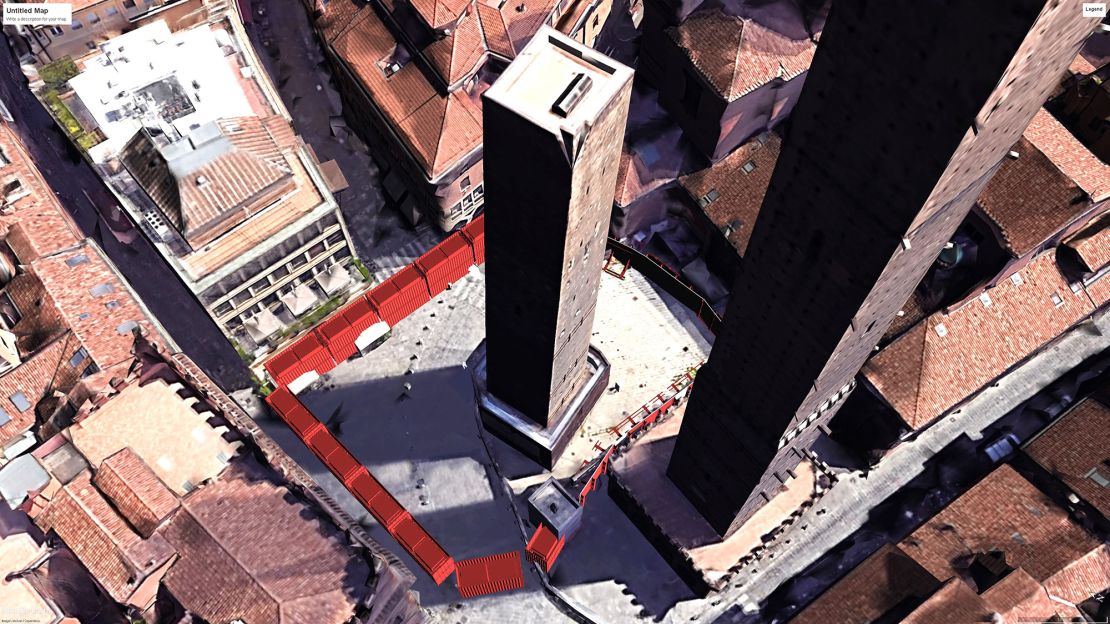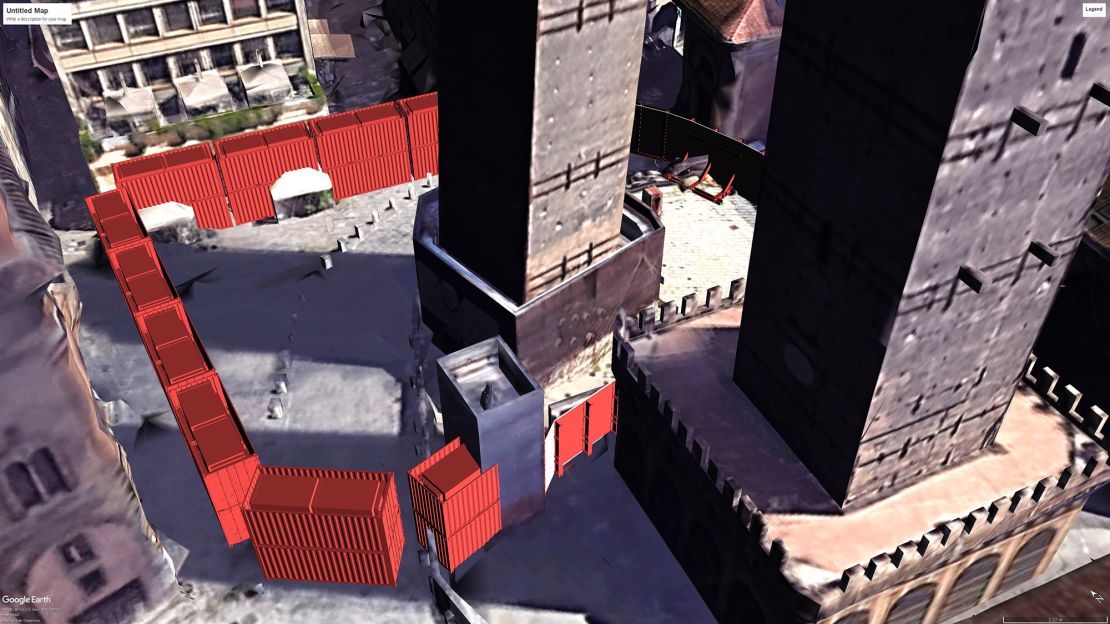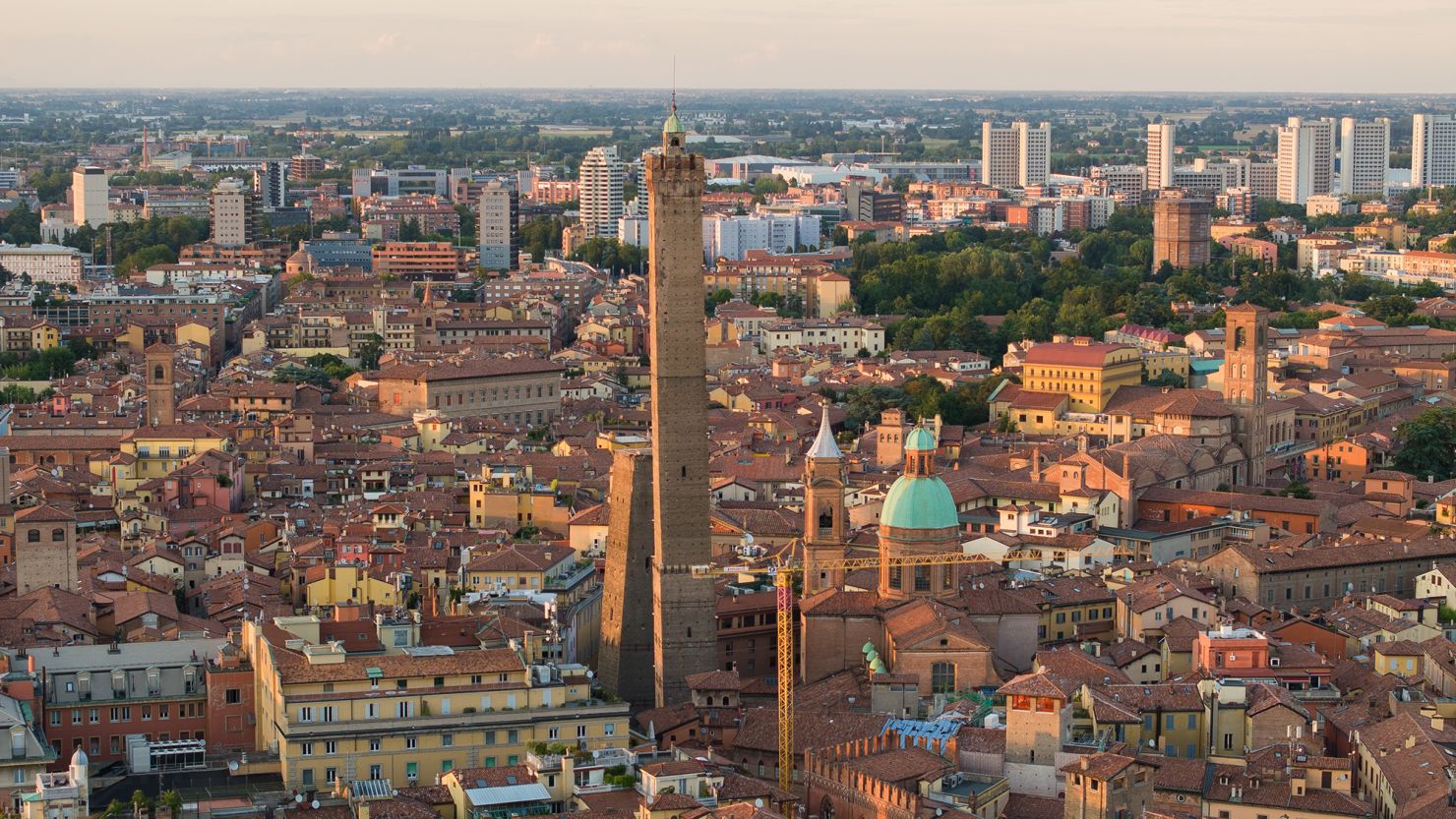Editor’s Note: Sign up to CNN Travel’s Unlocking Italy newsletter for insider intel on Italy’s best loved destinations and lesser-known regions to plan your ultimate trip. Plus, we’ll get you in the mood before you go with movie suggestions, reading lists and recipes from Stanley Tucci.
It’s the ‘leaning tower’ that has stood tipsily – but steadily – for nearly 1,000 years. But now, the days of the Garisenda tower in Bologna, Italy, could be numbered. Following investigations last month, the city is instigating a civil protection plan for the “sudden and unexpected collapse of the tower,” which has dominated the Bologna skyline since the 12th century.
A protective metal cordon will be erected to “contain debris resulting from a possible collapse, to reduce the vulnerability of surrounding buildings and the exposure to the population, as well as blocking access to the off-limits area,” the city council said in a statement.
The cordon will be fixed into the ground, and will include specially designed rockfall protection nets, also made of metal and also anchored to the ground.
The warning of a possible collapse was issued in a 27-page report, shared with CNN, by the scientific committee which has monitored the site since 2019.
It puts the site on “high alert” and states that experts “believe that safety conditions no longer exist to operate on or around the tower, except within the framework of a civil protection plan.”
Monitoring of the site over the past month has revealed an “unexpected and accelerated trend” of “crushing” compression to the base of the tower, with gradual disintegration of the stone used to clad the base and cracks expanding in the brick above, it says.
Consolidation works which were already underway have been halted and an exclusion zone is to be built “in the fastest time possible.”
However, the tower isn’t on the verge of immediate collapse, a spokesperson told CNN.
“We’re acting as if it’s the worst case scenario but that’s not to say it’ll happen,” he said, adding that the precautions are currently on “yellow” alert rather than red, where collapse is imminent.
“We’re acting as if it’s about to collapse, but nobody knows when that could be – it could be three months, 10 years, or 20 years.
“If there was an imminent risk of collapse we’d evacuate everyone,” he said, adding that the monitoring equipment delivers readings every 15 minutes, meaning that they should get warning of a collapse, and can evacuate the surrounding area.
An ode by Dante

One of Bologna’s famous “twin towers” which dominate the city center, the 48-meter (158 feet) Garisenda was built in the 12th century when Bologna was a mini Manhattan, with dozens of towers reaching towards the sky, each built by local families trying to construct theirs higher than the last. Today, few remain. Of those that do, many have had their tops lopped off and been converted into regular houses.
The Garisenda leans at an angle of four degrees – only a little more upright than the Leaning Tower of Pisa’s five degrees. It was already leaning by the early 14th century when Dante wrote “Inferno,” in which he described the dizzy rush of looking up at the Garisenda’s leaning side. Shortened in later years, it sits in the city center beside the Asinelli – a tower twice the height, which tourists could climb until last month.
Bologna’s mayor, Matteo Lepore, ordered the area around the towers to be blocked off in October, although the move to isolate them was for research reasons, rather than safety ones. Acoustic sensors were placed around the Garisenda to monitor cracking and creaking noises, while a pendulum was installed in both towers to track movement and see if regular “oscillation” was going above a certain threshold.
That research has now found not only increased compression in the base of the tower, but that the lean of the tower has started to shift 90 degrees, from an easterly or southeasterly direction to southwards.
The conditions have been steadily declining since July, said a spokesperson for the city council.
‘Inescapably critical condition’

Gradual disintegration of the rock attached to the base, as well as vertical cracks in the bricks that make up the tower, have been noted since 2020 but have now worsened.
The report, which was published on November 15, confirms that the tower has been in an “inescapably critical condition for some time,” and suggests that previous interventions, including a “hoop” of steel rods and cables around the base in 2020, have aggravated the situation.
“The overall situation has unfortunately worsened considerably, with worrying implications for the overall stability of the tower,” reads the report.
“The unexpected and accelerated trend leads the committee to immediately suspend all activities currently underway (especially consolidation) and to put the site on high alert. [The committee believes] that safety conditions no longer exist to operate on or around the tower, except within the framework of a civil protection plan.”
Extreme weather events, including high temperatures this summer and flooding earlier this year, also appear to have played a part, according to the council spokesperson.
Red alert

Materials for the protective cordon will be delivered to a site near the tower within the next couple of weeks, with the works due to be completed by February, according to the council.
But anyone who was hoping that the cordon would fit in with the medieval buildings around it will be disappointed by the renderings, which show bright red barriers around the Garisenda. However, it is hopefully only temporary – the report stipulates that any anti-collapse measures must be reversible.
The council spokesperson said that once the cordon has been installed, new research will be undertaken in two phases: first to find a solution to stabilize the tower, and then to resolve the underlying problem.
He said that the first phase might mean creating a metal “cage” for the structure. The second phase is causing more debate.
“Some say let’s dismantle it, redo the base and rebuild it. Others say let’s trim it [the tower itself] as was done in the medieval period. These are all hypotheses that we’re studying – the tower is nearly 1,000 years old and there’s no rulebook,” he said.
The works won’t come cheap – the cordon alone will cost 4.4 million euros (about $4.8 million), and any stabilizing work will cost “millions and millions,” said the spokesperson. The council has set up an online fundraiser with an aim of raising 3 million euros. It has already raised 800,000 euros in a week.
“The twin towers are one of the symbols of the city, along with the [UNESCO-protected] porticoes,” said the spokesperson.
“This isn’t just about saving a heritage site; it also has a very strong symbolic value.”



